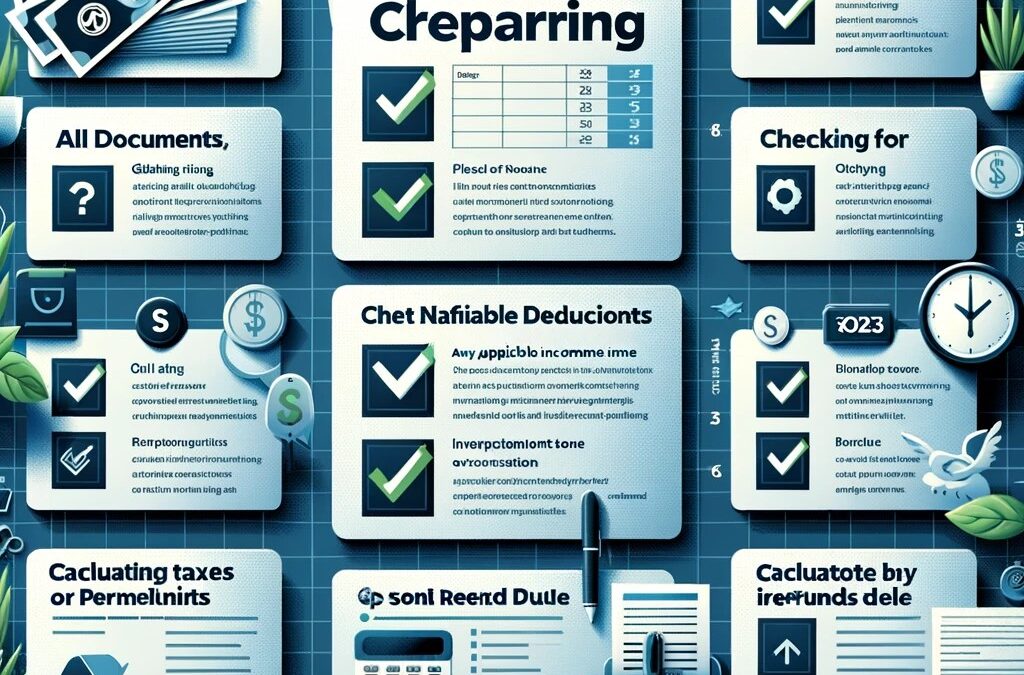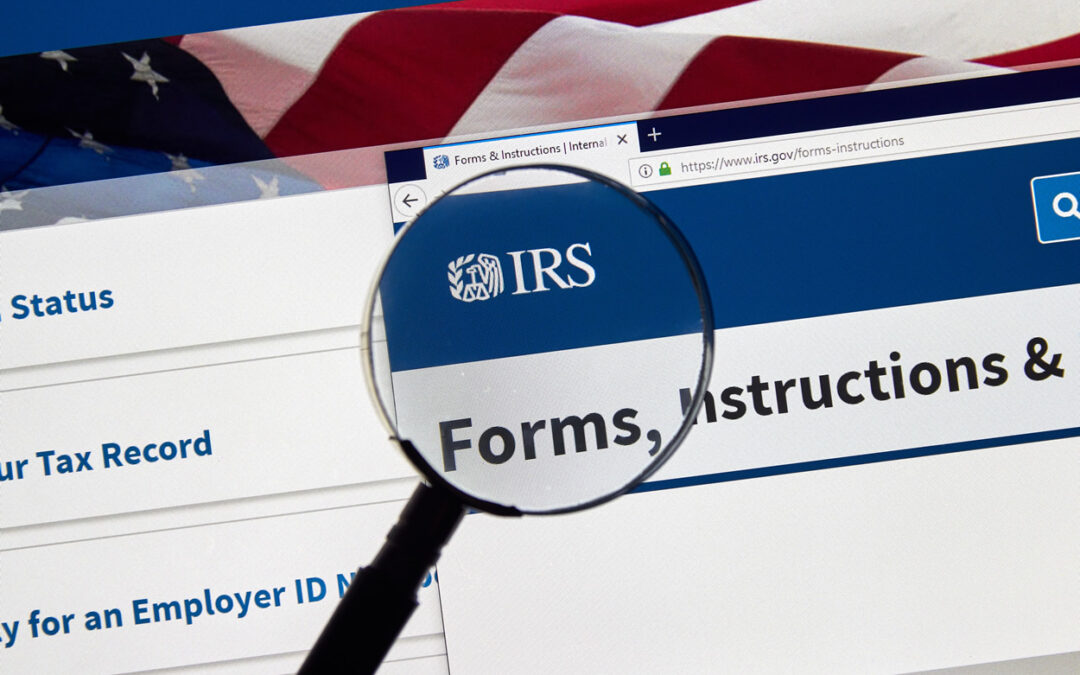
by sreamercpa | Feb 13, 2024 | 2023-irs-tax-return-checklist
Issue Number: IR-2024-28
Things to remember when filing 2023 tax returns
WASHINGTON —The Internal Revenue Service today offered a checklist to help taxpayers as they prepare to file their 2023 tax returns during filing season.
These six easy tips will help make tax preparation smoother in 2024. Much of this information is also available on a special IRS.gov free help page:
1. Gather all necessary tax paperwork and records for accuracy to avoid missing a deduction or credit. Taxpayers should have all their important and necessary documents before preparing their return. This will help file a complete and accurate tax return. Errors and omissions slow down tax processing, including refund times.
Before beginning, taxpayers should have:
- Social Security numbers for everyone listed on the tax return.
- Bank account and routing numbers.
- Various tax forms such as W-2s, 1099s, 1098s and other income documents or records of digital asset transactions.
- Form 1095-A, Health Insurance Marketplace statement.
- Any IRS letters citing an amount received for a certain tax deduction or credit.
2. Remember to report all types of income on the tax return. This is important to avoid receiving a notice or a bill from the IRS. Don’t forget to include income from:
- Goods created and sold on online platforms.
- Investment income.
- Part-time or seasonal work.
- Self-employment or other business activities.
- Services provided through mobile apps.
3. Filing electronically with direct deposit is the fastest way to receive a refund. Avoid paper returns. Tax software helps individuals avoid mistakes by doing the math. It guides people through each section of their tax return using a question-and-answer format.
For those waiting on their 2022 tax return to be processed, here’s a special tip to ensure their 2023 tax return is accepted by the IRS for processing. Make sure to enter $0 (zero dollars) for last year’s adjusted gross income (AGI) on the 2023 tax return. Everyone else should enter their prior year’s AGI from last year’s return.
4. Free resources are available to help eligible taxpayers file online. Free help may also be available to qualified taxpayers. IRS Free File provides a free online alternative to filing a paper tax return. IRS Free File is available to any individual or family who earned $79,000 or less in 2023.
With IRS Free File, leading tax software providers make their online products available for free as part of a 21-year partnership with the IRS. This year, there are eight products in English and one in Spanish. Taxpayers must access these products through the IRS website.
People who make over $79,000 can use the IRS’ Free File Fillable Forms. These are the electronic version of IRS paper forms. This product is best for people who are comfortable preparing their own taxes.
Qualified taxpayers can also find free one-on-one tax preparation help around the nation through the Volunteer Income Tax Assistance (VITA) and Tax Counseling for the Elderly (TCE) programs.
5. Consider which filing option to use; each one has its own benefits. Taxpayers should decide based on their personal situation and comfort level with tax preparation.
6. Don’t wait on hold when calling the IRS. Use online resources at IRS.gov to get answers to tax questions, check a refund status or pay taxes. There’s no wait time or appointment needed — online tools and resources are available 24 hours a day. The IRS’ Interactive Tax Assistant tool and Let Us Help You resources are especially helpful.
Stay updated
Additionally, the IRS suggests taxpayers stay up to date on important tax information online by:

by sreamercpa | Mar 29, 2023 | accounting-tax, IRS, maryland-taxes, reisterstown-md-cpa, tax-planning
Dirty Dozen: Taking tax advice on social media can be bad news for taxpayers; schemes circulating involving tax forms
WASHINGTON – The Internal Revenue Service today continued the Dirty Dozen series with a warning on day seven about trusting tax advice on social media that can lure otherwise honest taxpayers and tax professionals into compromising tax situations.
Social media can circulate inaccurate or misleading tax information, and the IRS has recently seen several examples. These can involve common tax documents like Form W-2 or more obscure ones, like Form 8944 that’s aimed at a very limited, specialized group. Both schemes encourage people to submit false, inaccurate information in hopes of getting a refund.
“There are many ways to get good tax information, including from a trusted tax professional, tax software and IRS.gov. But people should be incredibly wary about following advice being shared on social media,” said IRS Commissioner Danny Werfel. “The IRS continues to see a lot of inaccurate information that could get well-meaning taxpayers in trouble. People should remember that there is no secret way to fill out a form and simply get a larger refund that they aren’t entitled to. Remember, if it sounds too good to be true, it probably is.”
Fraudulent form filing and bad advice on social media are part of the 2023 IRS annual Dirty Dozen campaign – a list of 12 scams and schemes that put taxpayers and the tax professional community at risk of losing money, personal information, data and more.
Working together as the Security Summit, the IRS, state tax agencies and the nation’s tax industry have taken numerous steps since 2015 to warn people about common scams and schemes during tax season and beyond, including identity theft schemes. The Security Summit initiative is committed to protecting taxpayers, businesses and the tax system against fraud and identity theft.
Some items on this year’s Dirty Dozen list are new, while others are re-emerging. While the Dirty Dozen is not a legal document or a formal listing of agency enforcement priorities, it is intended to alert taxpayers and the tax professional community about various scams and schemes.
Trending on social media: Fraudulent form filing and bad advice
Social media can connect people and information from all over the world. Unfortunately, sometimes people provide bad advice that can lure good taxpayers into trouble. The IRS warns taxpayers to be wary of trusting internet advice, whether it’s a fraudulent tactic promoted by scammers or it’s patently false tax-related scheme trending across popular social media platforms.
The IRS is aware of various filing season hashtags and social media topics leading to inaccurate and potentially fraudulent information. The central theme involves people trying to use legitimate tax forms for the wrong reason. Here are just two of the recent schemes circulating online:
Form 8944 fraud
A recent example of bad advice circulating on social media that could lead to fraudulent form filing involves Form 8944, Preparer e-File Hardship Waiver Request. There are wildly inaccurate suggestions being made about this form. Posts claim that Form 8944 can be used by taxpayers to receive a refund from the IRS, even if the taxpayer has a balance due. This is false information. Form 8944 is for tax professional use only.
While Form 8944 is a legitimate IRS tax form, it’s intended for a targeted group of tax return preparers who are requesting a waiver so they can file tax returns on paper instead of electronically. It is not in any way a form the average taxpayer can use to avoid tax bills. Taxpayers who intentionally file forms with false or fraudulent information can face serious consequences, including potentially civil and criminal penalties.
Form W-2 fraud
This scheme, which is circulating on social media, encourages people to use tax software to manually fill out Form W-2, Wage and Tax Statement, and include false income information. In this W-2 scheme, scam artists suggest people make up large income and withholding figures as well as the employer its coming from. Scam artists then instruct people to file the bogus tax return electronically in hopes of getting a substantial refund.
The IRS, along with the Security Summit partners in the tax industry and the states, are actively watching for this scheme. In addition, the IRS works with payroll companies and large employers – as well as the Social Security Administration – to verify W-2 information.
The IRS and Summit partners warn people not to fall for this scam. Taxpayers who knowingly file fraudulent tax returns potentially face significant civil and criminal penalties.
How taxpayers can verify information
Keep in mind: If something sounds too good to be true, it probably is.
- gov has a forms repository with legitimate and detailed instructions for taxpayers on how to fill out the forms properly.
- Use IRS.gov, official IRS social media accounts, or other government sites to fact check information.
Make a difference: Report fraud, scams and schemes
As part of the Dirty Dozen awareness effort, the IRS encourages people to report individuals who promote improper and abusive tax schemes as well as tax return preparers who deliberately prepare improper returns.
To report an abusive tax scheme or a tax return preparer, people should mail or fax a completed Form 14242, Report Suspected Abusive Tax Promotions or Preparers and any supporting materials to the IRS Lead Development Center in the Office of Promoter Investigations.
Mail:
Internal Revenue Service Lead Development Center
Stop MS5040
24000 Avila Road Laguna Niguel, CA 92677-3405
Fax: 877-477-9135
Alternatively, taxpayers and tax practitioners may send the information to the IRS Whistleblower Office for possible monetary reward.
For more information, see Abusive Tax Schemes and Abusive Tax Return Preparers

by sreamercpa | Mar 3, 2023 | accounting-tax, IRS
WASHINGTON – The Internal Revenue Service issued a consumer alert today to warn taxpayers of new scams that urge people to use wage information on a tax return to claim false credits in hopes of getting a big refund.
One scheme, which is circulating on social media, encourages people to use tax software to manually fill out Form W-2, Wage and Tax Statement, and include false income information. In this W-2 scheme, scam artists suggest people make up large income and withholding figures as well as the employer it is coming from. Scam artists then instruct people to file the bogus tax return electronically in hopes of getting a substantial refund – sometimes as much as five figures – due to the large amount of withholding.
The IRS along with the Security Summit partners in the tax industry and the states, are actively watching for this scheme and others. In addition, the IRS works with payroll companies and large employers – as well as the Social Security Administration – to verify W-2 information.
With National Consumer Protection Week starting Monday, the IRS and Summit partners warn people not to fall for these scams.
“We are seeing signs this scam is increasing, and we worry that innocent taxpayers could be at risk of being tempted into falling into a trap that puts them at risk of financial and criminal penalties,” said Acting IRS Commissioner Doug O’Donnell. “The IRS and Security Summit partners remind people there is no secret way to get free money or a big refund. People should not make up income and try to submit a fraudulent tax return in hopes of getting a huge refund.”
Two variations of this scheme are also being seen by the IRS; both involve misusing Form W-2 wage information in hopes of generating a larger refund:
- One variation involves people using Form 7202, Credits for Sick Leave and Family Leave for Certain Self-Employed Individuals, to claim a credit based on income earned as an employee and not as a self-employed individual. These credits were available for self-employed individuals for 2020 and 2021 during the pandemic; they are not available for 2022 tax returns.
- A similar variation involves people making up fictional employees employed in their household and using Schedule H, Household Employment Taxes, to try claiming a refund based on false sick and family wages they never paid. The form is designed to report household employment taxes if a taxpayer hired someone to do household work and those wages were subject to Social Security, Medicare or FUTA taxes, or if the employer withheld federal income tax from those wages.
The IRS reminds people who try this that they face a wide range of penalties. This may include a frivolous return penalty of $5,000. Filers also run the risk of criminal prosecution for filing a false tax return.
For anyone who has participated in one of these schemes, there are several options that the IRS recommends. People can amend a previous tax return or consult with a trusted tax professional

by sreamercpa | Feb 16, 2023 | IRS
Issue Number: Tax Tip 2023-21
___________________________________________________________
This IRS online tool simplifies estimating 2023 tax withholding
A few minutes spent reviewing income tax withholding early in the year helps set a taxpayer up for success all year long. The Tax Withholding Estimator on IRS.gov makes it easy to figure out how much to withhold.
This online tool helps employees withhold the correct amount of tax from their wages. It also helps self-employed people who have wage income estimate their quarterly tax payments.
The Tax Withholding Estimator does not ask for personally identifiable information, such as name, Social Security number, address and bank account numbers. The IRS doesn’t save or record the information users enter in the Estimator.
Why use the Tax Withholding Estimator
Using this tool to estimate tax withholding can help taxpayers avoid unpleasant surprises. Having too little withheld can result in a tax bill or even a penalty at tax time. Having too much withheld may result in a projected refund, which could mean less money in the taxpayer’s pocket during the year. The Tax Withholding Estimator can help taxpayers decide how much to withhold to get to a balance of zero or to a desired refund amount.
Taxpayers can use the results from the Tax Withholding Estimator to decide if they should:
Before using the tool, taxpayers may want to gather a few documents, including:
People do not need these documents use the tool but having them will help taxpayers estimate 2023 income and answer other questions asked during the process. The Tax Withholding Estimator results will only be as accurate as the information the taxpayer enters.
The Tax Withholding Estimator isn’t for taxpayers who
- Only have pension income – They can read more about pension and annuity withholding on IRS.gov.
- Have more complex tax situations – This includes taxpayers who owe certain taxes such as the alternative minimum tax and people with long-term capital gains or qualified dividends.
More Information:
Publication 505, Tax Withholding and Estimated Tax
Share this tip on social media — #IRSTaxTip: This IRS online tool simplifies estimating 2023 tax withholding. http://ow.ly/wVRc50MUvu4

by sreamercpa | Feb 16, 2023 | accounting-tax, IRS
Issue Number: IR-2023-28
Inside This Issue
Avoid the rush: Presidents Day marks peak time period for calls; use IRS online tools in February to avoid delays, get tax help
WASHINGTON — With the nation entering a peak period for filing taxes, the Internal Revenue Service urges taxpayers to use online tools to get answers quickly and avoid phone delays during a traditional peak period for IRS phone lines around Presidents Day.
Presidents Day weekend, when many people prepare their taxes, historically marks a peak period for IRS phone lines. During the two week February period following Presidents Day, the IRS recommends turning first to the self-help tools available online on IRS.gov to avoid delays.
“The IRS continues to see improvements this tax season compared to previous years, including better phone service,” said IRS Acting Commissioner Doug O’Donnell. “But we always see a significant surge in phone traffic around Presidents Day. With the calendar advancing, millions of people turn their attention to taxes during this period. To avoid potential delays, we encourage people to check IRS.gov first, which can provide much of the same information instantly to taxpayers.”
Easy-to-use and available anytime, the IRS website can help taxpayers file and pay taxes, find information about their accounts, determine eligibility for tax credits and get answers to tax questions.
And when it comes time to file, taxpayers are encouraged to e-file and choose direct deposit to get their refunds as quickly as possible.
Available IRS tools to help taxpayers through tax filing season
The IRS recommends trying the following self-help resources available to taxpayers 24/7 for a smooth and easy tax filing experience.
- IRS.gov offers a variety of online tools to help taxpayers answer common tax questions. For example, taxpayers can search the Interactive Tax Assistant, Tax Topics and Frequently Asked Questions to find answers.
- The Earned Income Tax Credit Assistant allows taxpayers to check eligiblity for this valuable credit. Taxpayers can also calculate how much EITC they may get and find answers to EITC questions.
- IRS Online Account gives taxpayers secure access to personal tax account information including balance, payments and tax records with previous year’s adjusted gross income information.
- The IRS offers basic tax information in several languages to help taxpayers get the information they need to file a federal tax return and pay any tax owed.
- IRS Free File provides eligible taxpayers who want to prepare their own returns free tax preparation and the Volunteer Income Tax Assistance (VITA) or Tax Counseling for the Elderly (TCE) programs offer free tax help from certified volunteers at thousands of sites across the country.
- The “Where’s My Refund?” tool on IRS.gov and the IRS2Go app allow taxpayers to check the status of their refund within 24 hours after the IRS accepts their e-filed tax return. Where’s My Refund? updates once every 24 hours, usually overnight, so taxpayers don’t need to check more than once a day. Tax law prevents the IRS from issuing refunds that include the EITC and/or the Additional Child Tax Credit before Feb. 15. But not to worry, “Where’s My Refund?” should provide an updated refund status for most early filers by Feb. 18 and EITC/ACTC related refunds should be available in taxpayer bank accounts or on debit cards by Feb. 28 if they chose direct deposit and there are no other issues with their tax return.
- The Tax Withholding Estimator can help taxpayers determine the right amount of tax to have withheld from a paycheck. Taxpayers should submit a new Form W-4 to their employer if an adjustment is needed.
- The IRS Services Guide and the Let Us Help You page on IRS.gov can help taxpayers find additional ways to get help.
For those who need to talk to someone, the IRS has hired an additional 5,000 customer service representatives to help staff its toll-free customer service line. IRS Taxpayer Assistance Centers or TACs are another resource for individuals who need more than online tools or the IRS toll-free customer service line to solve a tax matter. Anyone who needs face-to-face service should make an appointment or check for special Saturday hours before visiting.
Missing information?
Taxpayers should call employers for missing Forms W-2. Those who did not receive a Form W-2, Wage and Tax Statement, from one or more employers by Jan. 31 should contact the issuer to inform them of the missing form.
Those who do not get a response from an issuer must still file on time and may need to use Form 4852, Substitute for Form W-2, Wage and Tax Statement, or Form 1099R, Distributions From Pensions, Annuities, Retirement or Profit-Sharing Plans, IRA’s Insurance Contracts, Etc.
For a copy of Form 1099 or 1042 to report Social Security income, visit the Social Security Administration website. These forms can be downloaded through my Social Security account. It’s fast and secure.





